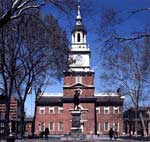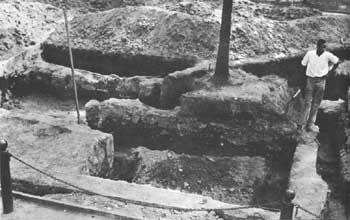





Survey of
Historic Sites and Buildings
 |
INDEPENDENCE NATIONAL HISTORICAL PARK Pennsylvania |
 Independence NHP |
| ||
Independence Hall is the heart of Independence National Historical Park. It was originally the statehouse for the Colony of Pennsylvania, built beginning in 1732. The Liberty Bell, displayed here, was ordered from England in 1751, and its famous "Proclaim Liberty" inscription was intended as a 50th anniversary memorial to William Penn's Charter of Privileges of 1701. The Second Continental Congress met in Independence Hall in May 1775 and took the crucial steps which converted a protest movement into a resistance and independence movement. Fighting had already broken out in Massachusetts when this Congress met, and they chose George Washington to be General and Commander in Chief of the Continental Army, in June 1775. He delivered his acceptance in Independence Hall. Next year, on July 4, 1776, the Declaration of Independence was adopted by Congress meeting here. It was written largely by Thomas Jefferson and stands as perhaps the finest statement of democratic rights and principles ever written, and the basis of the free government of the United States throughout its history.
During the War for Independence and the ensuing period under the Articles of Confederation, Congress met in various towns and cities, but Philadelphia remained the chief city of the United States. Thus, be ginning on May 25, 1787, the Federal Constitutional Convention met here under Washington, as President of the Convention. Benjamin Franklin, Alexander Hamilton, James Madison, and other eminent leaders made up the Convention, which labored for 4 months and produced the Constitution which, with amendments, continues today as the supreme law of the land. The meetings were held in strictest secrecy and the results submitted to every State for ratification. Americans will never fail to honor the wisdom and courage exhibited by the writers of the Constitution. The City of Philadelphia purchased Independence Hall from the Commonwealth of Pennsylvania in 1818—a financial and spiritual investment unequaled in the history of American cities—and thus took the first step to preserve it and surrounding structures for posterity. Great progress has been made recently by the Commonwealth in converting the three blocks directly north of Independence Hall into a mall, to enhance the setting of the park.
 |
| Archeological excavations in Independence Square. The foundation walls shown here belonged to buildings designed by Robert Mills, early 1800's. (National Park Service) |
Independence National Historical Park includes a number of other historic structures in addition to Independence Hall. Those in the Independence Hall group are owned by the City of Philadelphia and ad ministered by the National Park Service; some others are owned and occupied by certain associations. Carpenters' Hall is among the most important of the latter. It was built in 1770 as a guildhall for the Carpenters' Company of Philadelphia, and was the scene of action for the First Continental Congress in 1774. This building is open to the public under a cooperative agreement between the Carpenters' Company and the U.S. Department of the Interior, and is located on Chestnut Street between Fourth and Orianna Streets.
The structures most closely associated with Independence Hall are on Independence Square. The former County Court Building is on the west, the Old City Hall on the east, with the American Philosophical Society Building (Philosophical Hall) next to it. All but Old City Hall were completed before 1790, when Philadelphia became the Federal Capital. During this period the Court House became known as Congress Hall because Congress sat there and, similarly, City Hall in 1791 became the Supreme Court Building. Philosophical Hall is not open to the public. It is still the headquarters of the American Philosophical Society, founded in 1743 by Benjamin Franklin, the oldest society of its kind in the United States. Its library is in Library Hall, on Fifth Street, a reconstruction of the original home of the Library Company of Philadelphia, which was built in 1789-90.
Other features of, or associated with, Independence National Historical Park include: The First Bank of the United States, erected in 1795-97; The Second Bank of the United States, 1819-24; New Hall, 1791; Philadelphia Exchange, 1832-34; Bishop White House, 1786-87; Dilworth-Todd-Moylan House, 1775; Franklin Court, site of Benjamin Franklin's home from 1763 to 1790; Christ Church, 1727-54; St. Joseph's Church, 1838, but in earlier structures from 1733; St. Mary's Church, established in 1763; Deshler-Morris House, 5442 Germantown Avenue, erected 1772-73; St. George's Church, 1769; and Mikveh Israel Cemetery, 1738.
 |
 |
http://www.cr.nps.gov/history/online_books/colonials-patriots/sitea16.htm
Last Updated: 09-Jan-2005